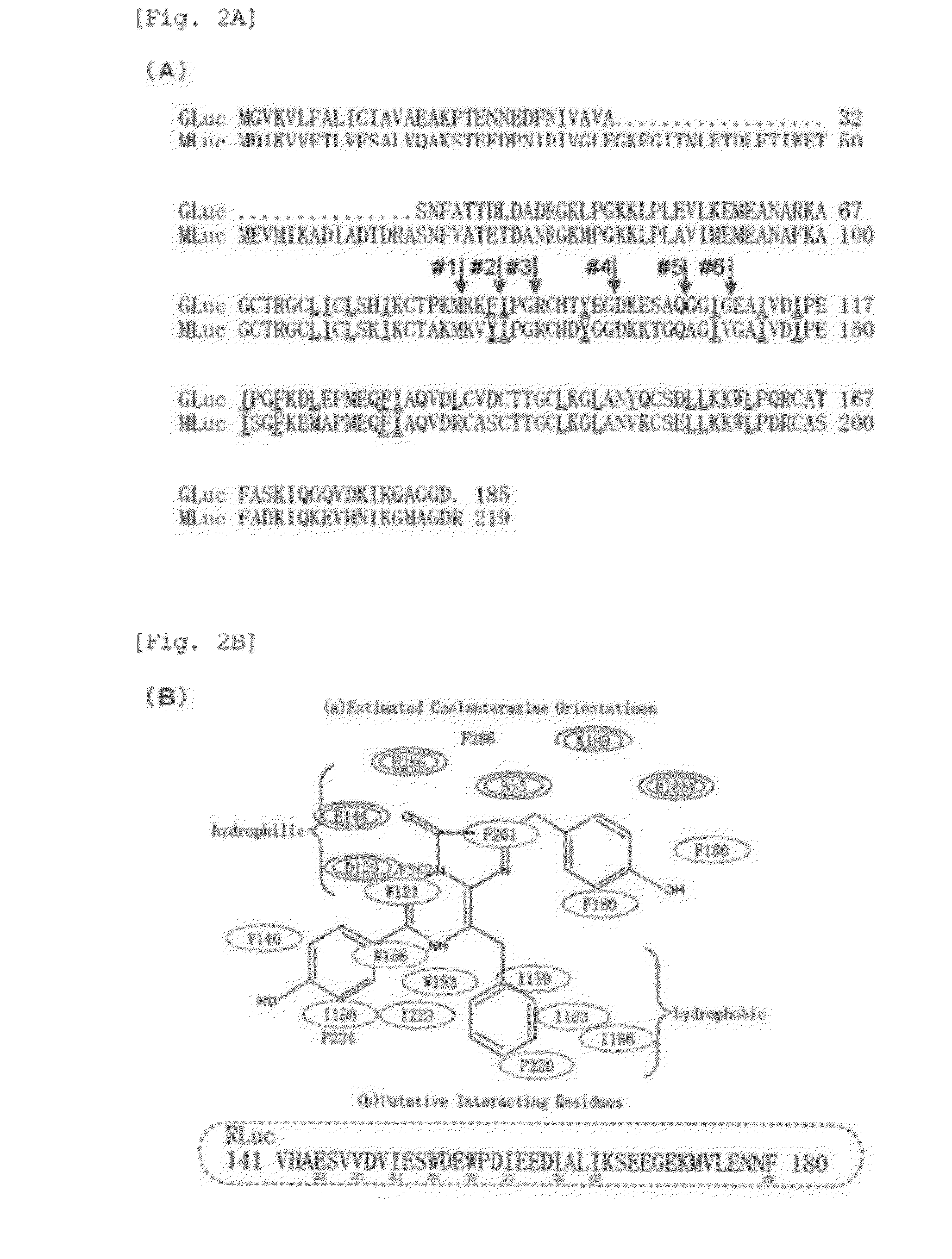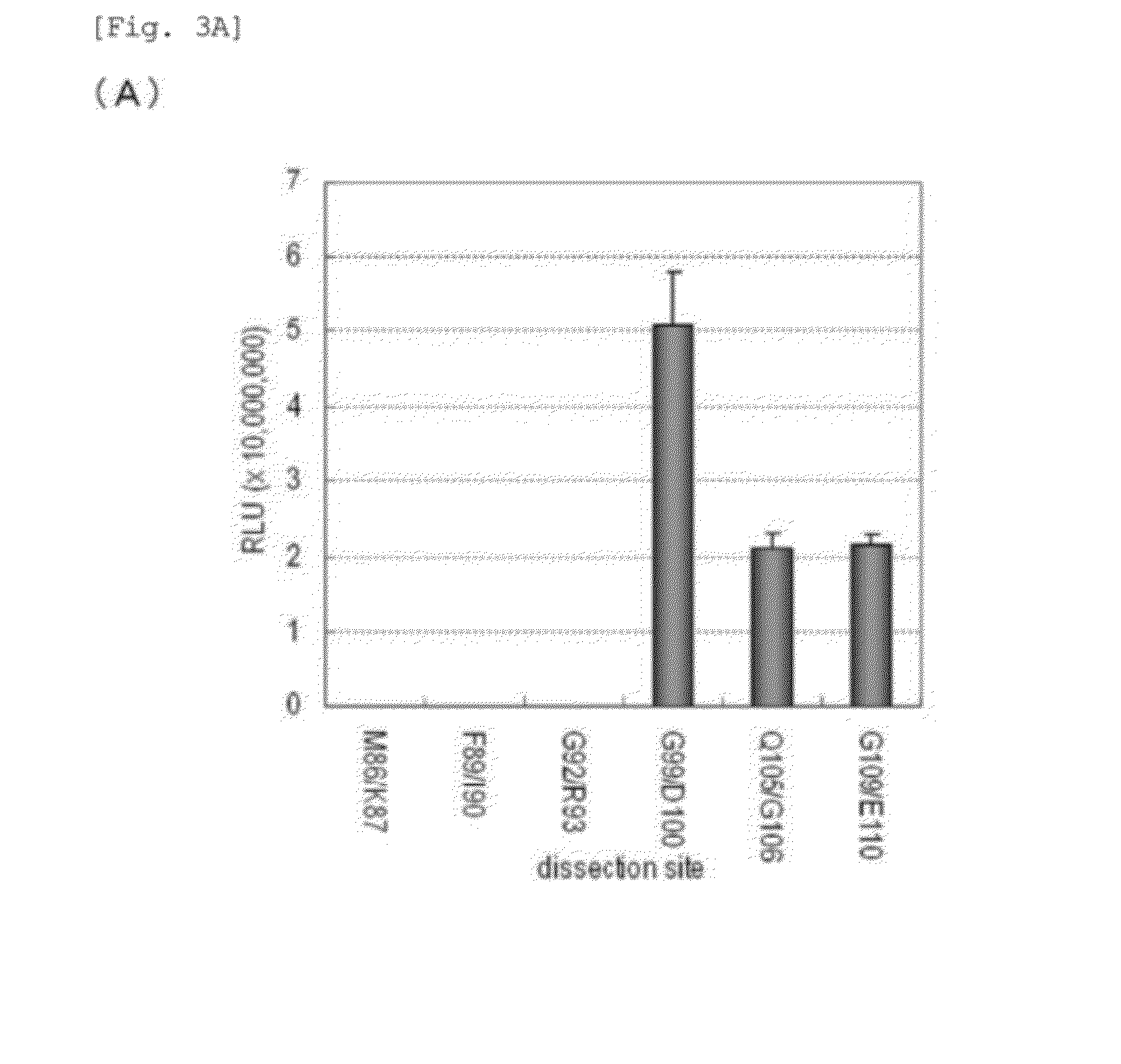Superluminescent luciferase variant with prolonged bioluminescence
a luciferase and superluminescent technology, applied in the field of superluminescent luciferase variants with prolonged bioluminescence, can solve the problems of affecting quantitative analysis, affecting the activity of luminescence enzymes, and affecting the maturation of fluorescence chromophores, etc., to achieve enhanced luminescence intensity, enhanced luminescence intensity, and enhanced luminance of luciferase
- Summary
- Abstract
- Description
- Claims
- Application Information
AI Technical Summary
Benefits of technology
Problems solved by technology
Method used
Image
Examples
example 1
Construction of Gene Sequence Encoding GLuc
[0219]In the determination of a new gene sequence based on a known gene sequence (GENE ACCESSION #: FJ010198) of Gaussia luciferase (GLuc), codons were optimized for known mammalian cells. Specifically, codons that contain many glycines and cysteines must be produced for the optimal expression in mammalian cells. For example, of two base codons, TTT and TTC, encoding phenylalanine among amino acids, TTC is more suitable for mammalian cells. Additionally, in order to increase the protein expression levels, a known Kozak sequence (GCCRCCATGG) was inserted before and after the translation initiation codon (AUG).
[0220]In order to generate the above gene sequence, sense and antisense primers were palindromically placed, and a PCR reaction was performed to synthesize the full-length sequence. The full-length GLuc was used as a genetic template upon introduction of other mutations in native GLuc. FIG. 2 shows the full length.
example 2
Search for the Enzyme Active Site in GLuc and Introduction of Mutations
[0221](2-1) The following inferences were made in the introduction of a mutation into native Gaussia Luciferase (GLuc).
[0222]Inference 1: Through a detailed observation of the crystallographic structure (FIG. 3C) formed by Renilla luciferase (RLuc) upon binding coelenterazine, which is a common substrate of marine luciferases, it was found that the active site of RLuc showed following properties:[0223](1) there is a region, where hydrophobic amino acids are found at certain intervals ranging Erom 2 to 4 amino acid residues, and[0224](2) the active site has a structure in which the substrate is sandwiched between hydrophilic and hydrophobic amino acid sites (FIG. 2B).
[0225]Through an examination of GLuc amino acid sequence, it was found that, in the region at a similar site (amino acid numbers 74-161), hydrophobic amino acids (isoleucine (I), leucine (L), valine (V), phenylalanine (F), tryptophan (W), and the like...
example 3
Comparison of Bioluminescence Intensities of GLuc into which Amino Acid Mutation has been Introduced
[0237]A pcDNA 3.1(+) vector into which the DNA of GLuc variants prepared in Example 2 was inserted was introduced into COS-7 cells cultured in a 12-well plate, followed by incubation for 16 hours.
[0238]Subsequently, cell lysates were prepared from the COS-7 cells in each well (5-minute lysis), and a spectrum was measured in the presence of a luciferase-specific substrate (coelenterazine), using a fluorescence spectrophotometer (F-7000, Hitachi), thereby examining the effect of the introduced mutation. FIGS. 4B-1 and 4C show the results. According to FIGS. 4B-1 and 4C, some variants were found to exhibit longer wavelength bioluminescence and remarkably high luminance compared to the original GLuc. Specifically, first, in the case of an introduction of a mutation that potentially induces an interaction between the substrate and a phenyl group, a redshift of about 10 nm was observed with...
PUM
| Property | Measurement | Unit |
|---|---|---|
| Wavelength | aaaaa | aaaaa |
| Hydrophilicity | aaaaa | aaaaa |
| Hydrophobicity | aaaaa | aaaaa |
Abstract
Description
Claims
Application Information
 Login to View More
Login to View More - Generate Ideas
- Intellectual Property
- Life Sciences
- Materials
- Tech Scout
- Unparalleled Data Quality
- Higher Quality Content
- 60% Fewer Hallucinations
Browse by: Latest US Patents, China's latest patents, Technical Efficacy Thesaurus, Application Domain, Technology Topic, Popular Technical Reports.
© 2025 PatSnap. All rights reserved.Legal|Privacy policy|Modern Slavery Act Transparency Statement|Sitemap|About US| Contact US: help@patsnap.com



